Endothelial FAK is essential for vascular network stability, cell survival, and lamellipodial formation
- PMID: 16391003
- PMCID: PMC2063542
- DOI: 10.1083/jcb.200506184
Endothelial FAK is essential for vascular network stability, cell survival, and lamellipodial formation
Abstract
Morphogenesis of a vascular network requires dynamic vessel growth and regression. To investigate the cellular mechanism underlying this process, we deleted focal adhesion kinase (FAK), a key signaling mediator, in endothelial cells (ECs) using Tie2-Cre mice. Targeted FAK depletion occurred efficiently early in development, where mutants exhibited a distinctive and irregular vasculature, resulting in hemorrhage and lethality between embryonic day (e) 10.5 and 11.5. Capillaries and intercapillary spaces in yolk sacs were dilated before any other detectable abnormalities at e9.5, and explants demonstrate that the defects resulted from the loss of FAK and not from organ failure. Time-lapse microscopy monitoring EC behavior during vascular formation in explants revealed no apparent decrease in proliferation or migration but revealed increases in cell retraction and death leading to reduced vessel growth and increased vessel regression. Consistent with this phenotype, ECs derived from mutant embryos exhibited aberrant lamellipodial extensions, altered actin cytoskeleton, and nonpolarized cell movement. This study reveals that FAK is crucial for vascular morphogenesis and the regulation of EC survival and morphology.
Figures
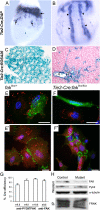
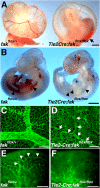


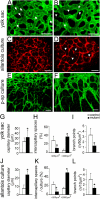
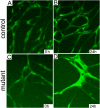
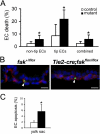


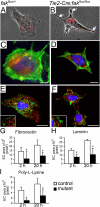
Similar articles
-
Conditional knockout of focal adhesion kinase in endothelial cells reveals its role in angiogenesis and vascular development in late embryogenesis.J Cell Biol. 2005 Jun 20;169(6):941-52. doi: 10.1083/jcb.200411155. J Cell Biol. 2005. PMID: 15967814 Free PMC article.
-
Focal adhesion kinase regulates smooth muscle cell recruitment to the developing vasculature.Arterioscler Thromb Vasc Biol. 2011 Oct;31(10):2193-202. doi: 10.1161/ATVBAHA.111.232231. Epub 2011 Jul 14. Arterioscler Thromb Vasc Biol. 2011. PMID: 21757658 Free PMC article.
-
Cdc42 is required for cytoskeletal support of endothelial cell adhesion during blood vessel formation in mice.Development. 2015 Sep 1;142(17):3058-70. doi: 10.1242/dev.125260. Epub 2015 Aug 7. Development. 2015. PMID: 26253403 Free PMC article.
-
Role of the vascular endothelial growth factor isoforms in retinal angiogenesis and DiGeorge syndrome.Verh K Acad Geneeskd Belg. 2005;67(4):229-76. Verh K Acad Geneeskd Belg. 2005. PMID: 16334858 Review.
-
Maturation of blood vessels by haematopoietic stem cells and progenitor cells: involvement of apelin/APJ and angiopoietin/Tie2 interactions in vessel caliber size regulation.Thromb Haemost. 2009 Jun;101(6):999-1005. Thromb Haemost. 2009. PMID: 19492139 Review.
Cited by
-
The effects of focal adhesion kinase on the motility, proliferation and apoptosis of Caco2 and SMMC-7721 cells.Med Oncol. 2015 Apr;32(4):125. doi: 10.1007/s12032-015-0567-1. Epub 2015 Mar 20. Med Oncol. 2015. PMID: 25790781
-
Soluble THSD7A is an N-glycoprotein that promotes endothelial cell migration and tube formation in angiogenesis.PLoS One. 2011;6(12):e29000. doi: 10.1371/journal.pone.0029000. Epub 2011 Dec 14. PLoS One. 2011. PMID: 22194972 Free PMC article.
-
Hyperphosphorylated FAK Delocalizes from Focal Adhesions to Membrane Ruffles.J Oncol. 2010;2010:932803. doi: 10.1155/2010/932803. Epub 2010 Aug 19. J Oncol. 2010. PMID: 20847951 Free PMC article.
-
Erk1 and Erk2 regulate endothelial cell proliferation and migration during mouse embryonic angiogenesis.PLoS One. 2009 Dec 14;4(12):e8283. doi: 10.1371/journal.pone.0008283. PLoS One. 2009. PMID: 20011539 Free PMC article.
-
Focal adhesion kinase modulates tension signaling to control actin and focal adhesion dynamics.J Cell Biol. 2007 Feb 26;176(5):667-80. doi: 10.1083/jcb.200608010. J Cell Biol. 2007. PMID: 17325207 Free PMC article.
References
-
- Alavi, A., J.D. Hood, R. Frausto, D.G. Stupack, and D.A. Cheresh. 2003. Role of Raf in vascular protection from distinct apoptotic stimuli. Science. 301:94–96. - PubMed
-
- Ausprunk, D.H., and J. Folkman. 1977. Migration and proliferation of endothelial cells in preformed and newly formed blood vessels during tumor angiogenesis. Microvasc. Res. 14:53–65. - PubMed
Publication types
MeSH terms
Substances
Grants and funding
LinkOut - more resources
Full Text Sources
Other Literature Sources
Molecular Biology Databases
Miscellaneous

